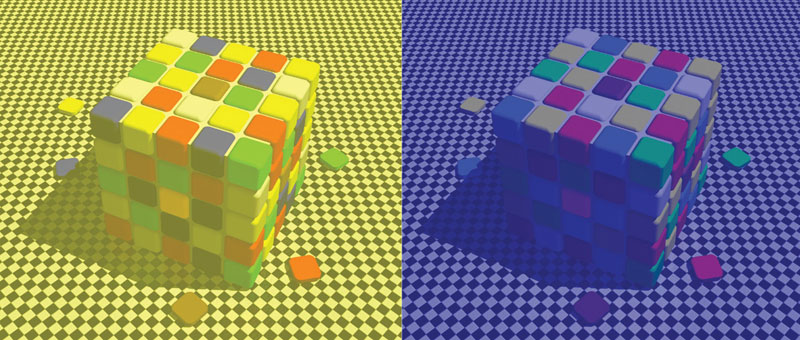
Check out the red chips in these two Rubik cubes. Though these chips in the two pictures might look like the same colour, only shaded differently, the ones on the left are actually orange and the ones on the right are purple. Don’t stress yourself too much with this, because it will likely get you nowhere. A four-month infant, however, can spot these differences instantly.
That’s because very young babies haven’t yet developed a crucial perceptual skill that enables us to navigate the world properly, something called perceptual consistency, also known as Object Constancy, or Constancy Phenomenon.
To understand how this works, we first need to establish that what our retinas record is different from the images decoded by the brain that we know as sight. This evolutionary adaption appeared because otherwise our minds would simply be engulfed in chaos by the constantly shifting lighting conditions, but also the shape of objects.
Imagine what it’s like to be consciously aware of people growing physically bigger as they approach you, objects changing shape as they move or colours changing as the lighting changes. You won’t be able to do anything as you try to wrap your mind around all the chaos. That’s why our brains rely on a perception and not recording, making it so things like site, shape, lightness and colour are consistent. Although a bus moving towards a bus stop changes in size from a dot to twice your height, we don’t perceive it as having grown in size — we’re capable of realising the bus has the same size, rectangular shape, and brightness as it had in the distance.
It’s really a game changer, although some faulty information like optical illusions sometimes slip in — a small price to pay, really, for the ability to make sense of the world. But little babies don’t have this consistency fully developed yet. The three snails in the image below, for instance, were featured in a recent paper published by Japanese psychologists at the Chuo University led by Professor Jiale Yang. Which two images are the most similar out of the three?

If you answered A and B, you’re wrong — it’s B and C, as these two images of the snail are the most similar in terms of pixel intensity. Even though the physical disparities between B and C are small, we adults think this pair looks the most different. Infants, however, were able to identify the right discrepant pair almost immediately, the researchers found.
Of course, you can’t ask a baby which pair is the most similar because “ga, ga, guu”. Instead, Yang and colleagues enlisted 42 babies, aged 3 to 8 months and put them in front of a computer screen with images rendered from real 3-D objects such as the snails. Previously, it was established that when babies are presented with a novel object, they spend more time looking at it than a familiar item. The researchers found the babies looked at the first and second image for an equivalent amount of time, suggesting they found both images novel and different.
The data shows infants aged 3 to 4 months old have a striking ability to spot physical disparities between images, but this ability is gradually lost starting at the age of 5 months. Around age 7 to 8 months, the babies start to discriminate surface properties like glossy vs. matte and lose this skill.
Previously, other research found that as babies grow up they lose other perceptual skills that adults don’t have like being able to differentiate between very subtle differences in the faces of monkeys, or the ability to distinguish speech sounds in languages other than spoken by their own families. Four-month-old babies are also able to tell which crossed foot actually got a tickle, unlike adults who often mistake which hand is getting touched when they cross their hands, for instance.
In other words, we’re most objective during our very first months of life but gradually slip into subjectivity as we age.
Was this helpful?



